Birds Seen in the garden
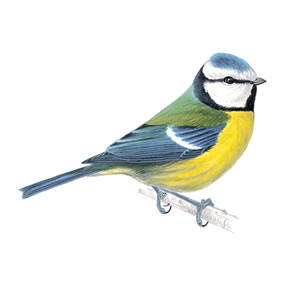 Blue Tit
Blue Tit
Its colourful mix of blue, yellow, white and green make the blue tit one of the most attractive resident garden birds. Almost any garden with a peanut feeder will attract them and they readily breed in nestboxes. In winter they form flocks with other tit species and a garden with four or five at a bird table at any one time, may be feeding 20 or more.
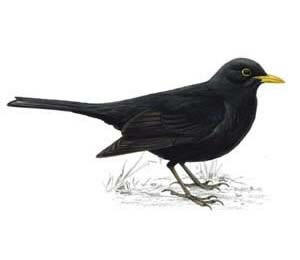 Blackbird
Blackbird
The males live up to their name but, confusingly, females are brown often with spots and streaks on their breasts. The bright orange-yellow beak and eye-ring make adult male blackbirds one of the most striking garden birds. One of the commonest UK birds, its mellow song is also a favourite.
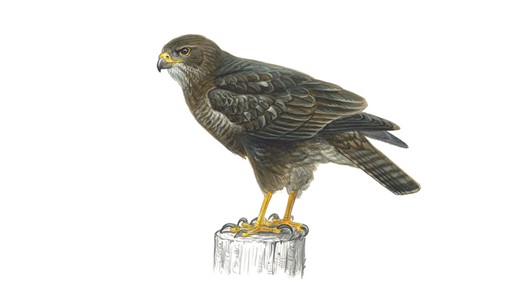 Buzzard
Buzzard
Now the commonest and most widespread UK bird of prey. It is quite large with broad, rounded wings, and a short neck and tail. When gliding and soaring it will often hold its wings in a shallow 'V' and the tail is fanned. Birds are variable in colour from all dark brown to much paler variations, all have dark wingtips and a finely barred tail. Their plaintive mewing call could be mistaken for a cat.
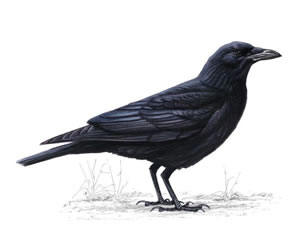 Carrion Crow
Carrion Crow
The all-black carrion crow is one of the cleverest, most adaptable of our birds. It is often quite fearless, although it can be wary of man. They are fairly solitary, usually found alone or in pairs. The closely related hooded crow has recently been split as a separate species. Carrion crows will come to gardens for food and although often cautious initially, they soon learn when it is safe, and will return repeatedly to take advantage of whatever is on offer.
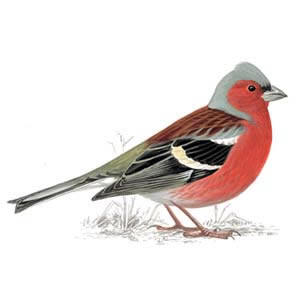 Chaffinch
Chaffinch
The chaffinch is the UK's second commonest breeding bird, and is arguably the most colourful of the UK's finches. Its patterned plumage helps it to blend in when feeding on the ground and it becomes most obvious when it flies, revealing a flash of white on the wings and white outer tail feathers. It does not feed openly on bird feeders - it prefers to hop about under the bird table or under the hedge. You'll usually hear chaffinches before you see them, with their loud song and varied calls.
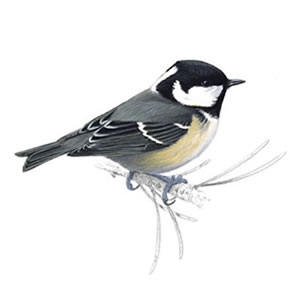 Coal Tit
Coal Tit
Not as colourful as some of its relatives, the coal tit has a distinctive grey back, black cap, and white patch at the back of its neck. Its smaller, more slender bill than blue or great tits means it can feed more successfully in conifers. A regular visitor to most peanut feeders, they will take and store food for eating later. In winter they join with other tits to form flocks which roam through woodlands and gardens in search of food.
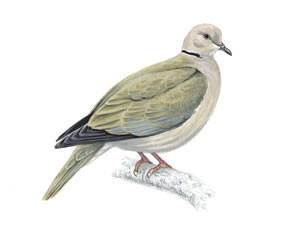 Collared Dove
Collared Dove
Distinctive with its buffy-pink plumage and black neck collar, it is usually seen singly or in pairs, although flocks may form where food is plentiful. It feeds on the ground but readily perches on roofs and wires. After rapidly spreading across Europe in the early half of the 20th century, the collared dove is now one of our most common birds and its monotonous cooing is a familiar sound.
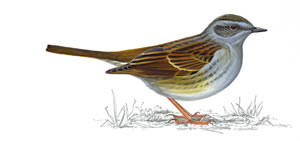 Dunnock
Dunnock
A small brown and grey bird. Quiet and inobtrusive, it is often seen on its own, creeping along the edge of a flower bed or near to a bush, moving with a rather nervous, shuffling gait, often flicking its wings as it goes. When two rival males come together they become animated with lots of wing-flicking and loud calling.
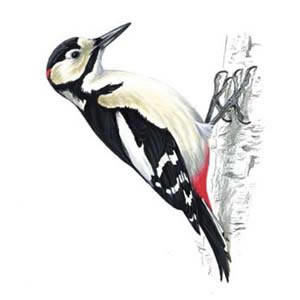 Greater Spotted Woodpecker
Greater Spotted Woodpecker
About blackbird-sized and striking black-and-white. It has a very distinctive bouncing flight and spends most of its time clinging to tree trunks and branches, often trying to hide on the side away from the observer. Its presence is often announced by its loud call or by its distinctive spring 'drumming' display. The male has a distinctive red patch on the back of the head and young birds have a red crown.
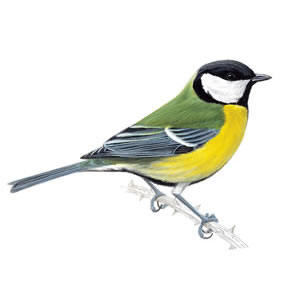 Great Tit
Great Tit
The largest UK tit - green and yellow with a striking glossy black head with white cheeks and a distinctive two-syllable song. It is a woodland bird which has readily adapted to man-made habitats to become a familiar garden visitor. It can be quite aggressive at a bird table, fighting off smaller tits. In winter it joins with blue tits and others to form roaming flocks which scour gardens and countryside for food.
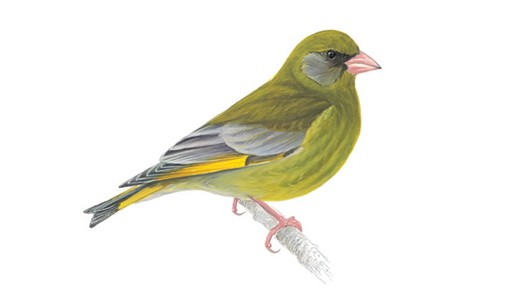 Greenfinch
Greenfinch
Its twittering and wheezing song, and flash of yellow and green as it flies, make this finch a truly colourful character. Nesting in a garden conifer, or feasting on black sunflower seeds, it is a popular garden visitor, able to take advantage of food in town and city gardens at a time when intensive agriculture has deprived it of many weed seeds in the countryside. Although quite sociable, they may squabble among themselves or with other birds .
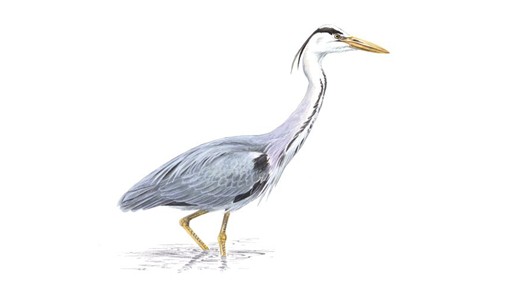 Grey Heron
Grey Heron
Grey herons are unmistakeable: tall, with long legs, a long beak and grey, black and white feathering. They can stand with their neck stretched out, looking for food, or hunched down with their neck bent over their chest.
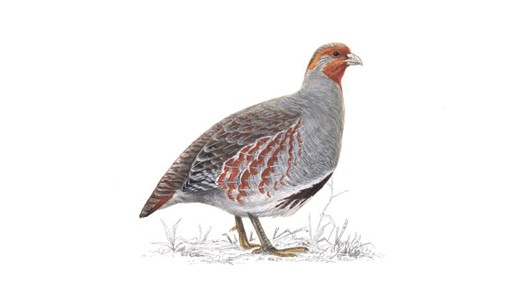 Grey Partridge
Grey Partridge
A medium-sized, plump gamebird with a distinctive orange face. Flies with whirring wings and occasional glides, showing a chestnut tail. It is strictly a ground bird, never likely to be found in pear trees! Groups of 6-15 (known as coveys) are most usually seen outside the breeding season. Once very common and widespread, it has undergone serious declines throughout most of its range and is a Red List species.
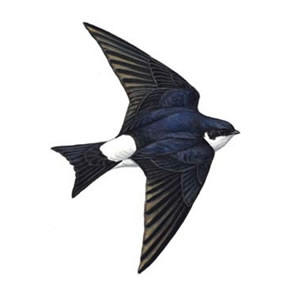 House Martin
House Martin
The house martin is a small bird with glossy blue-black upper parts and pure white under parts. It has a distinctive white rump with a forked tail and, on close inspection, white feathers covering its legs and toes. It spends much of its time on the wing collecting insect prey. The bird's mud nest is usually sites below the eaves of buildings. They are summer migrants and spend their winters in Africa. Although still numerous and widespread, recent moderate declines earn them a place on the Amber List.
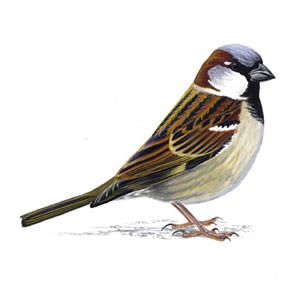 House Sparrow
House Sparrow
Noisy and gregarious, these cheerful exploiters of man's rubbish and wastefulness, have even managed to colonise most of the world. The ultimate opportunist perhaps, but now struggling to survive in the UK along with many other once common birds. They are clearly declining in both gardens and the wider countryside and their recent declines have earned them a place on the Red List.
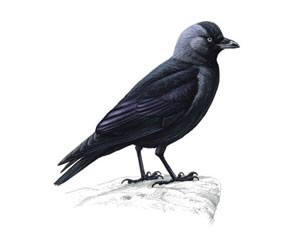 Jackdaw
Jackdaw
A small black crow with a grey neck and pale eyes. It is sociable and usually seen in pairs or larger groups. It is quite and acrobatic flier and flocks will often chase and tumble together in flight. On the ground it both walks and hops.
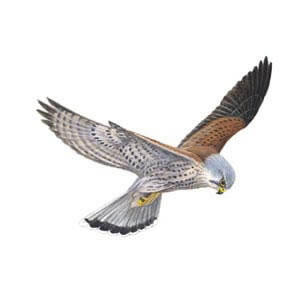 Kestrel
Kestrel
A familiar sight with its pointed wings and long tail, hovering beside a roadside verge. Kestrels have been recently declining as a result of habitat degradation due to continuing intensive management of farmland and so it is included on the Amber List. They have adapted readily to man-made environments and can survive right in the centre of cities.
 Kingfisher
Kingfisher
Kingfishers are small unmistakable bright blue and orange birds of slow moving or still water. They fly rapidly, low over water, and hunt fish from riverside perches, occasionally hovering above the water's surface. They are a vulnerable to hard winters and habitat degradation through pollution or unsympathetic management of watercourses. Kingfishers are amber listed because of their unfavourable conservation status in Europe.
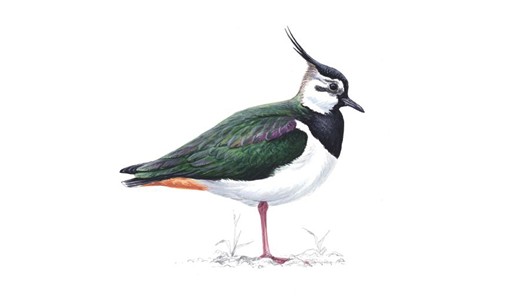 Lapwing
Lapwing
Also known as the peewit in imitation of its display calls, its proper name describes its wavering flight. Its black and white appearance and round-winged shape in flight make it distinctive, even without its splendid crest. This familiar farmland bird has suffered significant declines recently and is now an Red List species.
 Jay
Jay
Although they are the most colourful members of the crow family, jays are actually quite difficult to see. They are shy woodland birds, rarely moving far from cover. The screaming call usually lets you know a jay is about and it is usually given when a bird is on the move, so watch for a bird flying between the trees with its distinctive flash of white on the rump. Jays are famous for their acorn feeding habits and in the autumn you may see them burying acorns for retrieving later in the winter.
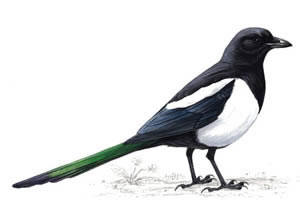 Magpie
Magpie
Magpies seem to be jacks of all trades - scavengers, predators and pest-destroyers, their challenging, almost arrogant attitude has won them few friends. With its noisy chattering, black-and-white plumage and long tail, there is nothing else quite like the magpie in the UK. When seen close-up its black plumage takes on an altogether more colourful hue with a purplish-blue iridescent sheen to the wing feathers, and a green gloss to the tail. Non-breeding birds will gather together in flocks.
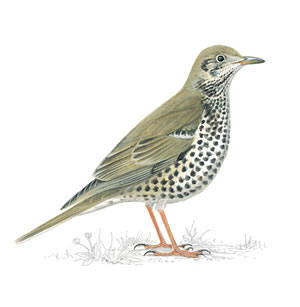 Mistle Thrush
Mistle Thrush
This is a pale, black-spotted thrush - large, aggressive and powerful. It stands boldly upright and bounds across the ground while in flight, it has long wings and its tail has whitish edges. It is most likely to be noticed perched high at the top of a tree, singing its fluty song or giving its rattling call in flight.
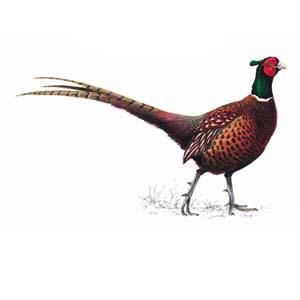 Pheasant
Pheasant
A large, long-tailed gamebird. Males have rich chestnut, golden-brown and black markings on body and tail, with a dark green head and red face wattling. Females are mottled with paler brown and black. They were introduced to the UK long ago and more recent introductions have brought in a variety of races and breeds for sport shooting.
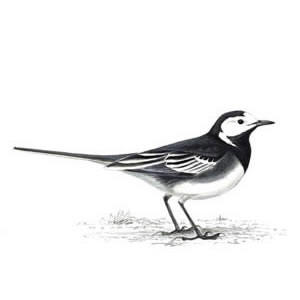 Pied Wagtail
Pied Wagtail
A delightful small, long-tailed and rather sprightly black and white bird. When not standing and frantically wagging its tail up and down it can be seen dashing about over lawns or car parks in search of food. It frequently calls when in its undulating flight and often gathers at dusk to form large roosts in city centres.
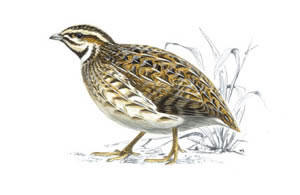 Quail
Quail
A small gamebird - the combination of its stocky body and long, pointed wings makes it quite distinctive. Its upperparts are brown, streaked and barred with buff, while its underparts are a warm buffy orange. Rarely seen it is more usually heard giving its distinctive 'wet-my lips' call. It is the UK's only migrant gamebird, reaching the northern fringes of the its breeding range here. It is a Red List species because of its historical decline as a UK breeding species.
 Robin
Robin
The UK's favourite bird - with its bright red breast it is familar throughout the year and especially at Christmas! Males and females look identical, and young birds have no red breast and are spotted with golden brown. Robins sing nearly all year round and despite their cute appearance, they are aggressively territorial and are quick to drive away intruders. They will sing at night next to street lights.
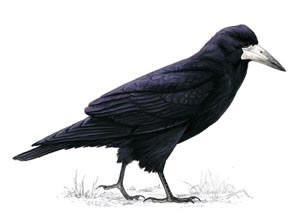 Rook
Rook
Bare, greyish-white face, thinner beak and peaked head make it distinguishable from the carrion crow. Rooks are very sociable birds, and you're not likely to see one on its own. They feed and roost in flocks in winter, often together with jackdaws.
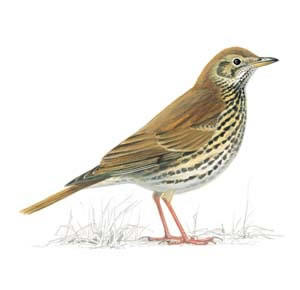 Song Thrush
Song Thrush
A familiar and popular garden songbird whose numbers are declining seriously, especially on farmland making it a Red List species. Smaller and browner than a mistle thrush with smaller spotting. Its habit of repeating song phrases distinguish it from singing blackbirds. It likes to eat snails which it breaks into by smashing them against a stone with a flick of the head.
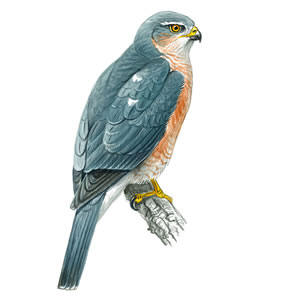 Sparrowhawk
Sparrowhawk
Adult males have a slate grey back and white underparts, closely barred with orange. Their grey tail has 4-5 dark bars. Females are larger, with brown upperparts, a white stripe over the eye and dark barring underneath. They look heavier than the males. Their broad, rounded wings and long tail are adapted for flying between trunks and branches enabling them to weave in and out of trees at high speed. They never hover like kestrels.
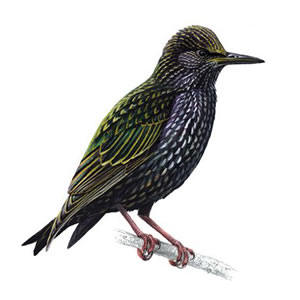 Starling
Starling
Smaller than blackbirds, with a short tail, pointed head, triangular wings, starlings look black at a distance but when seen closer they are very glossy with a sheen of purples and greens. Their flight is fast and direct and they walk and run confidently on the ground. Noisy and gregarious, starlings spend a lot of the year in flocks. Still one of the commonest of garden birds, its decline elsewhere makes it a Red List species.
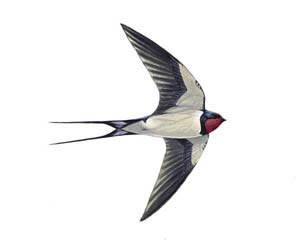 Swallow
Swallow
Swallows are small birds with dark glossy blue backs, red throats, pale under parts and long distinctive tail streamers. They are extremely agile in flight and spend most of their time on the wing. They are widespread breeding birds in the Northern Hemisphere, migrating south in winter. Recent declines due to loss of habitat quality in both their breeding and wintering grounds mean they are an Amber List species.
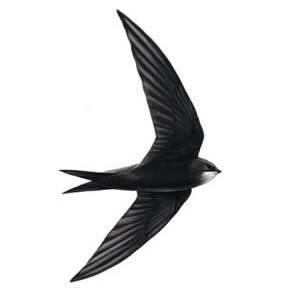 Swift
Swift
The swift is a medium-sized aerial bird, which is a superb flier. It evens sleeps on the wing! It is plain sooty brown, but in flight against the sky it appears black. It has long, scythe-like wings and a short, forked tail. It is a summer visitor, breeding across the UK, but most numerously in the south and east. It winters in Africa.
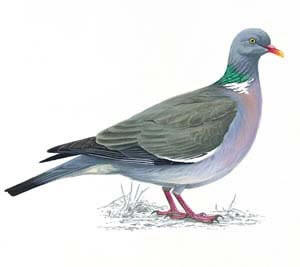 Woodpigeon
Woodpigeon
The UK's largest and commonest pigeon, it is largely grey with a white neck patch and white wing patches, clearly visible in flight. Although shy in the countryside it can be tame and approachable in towns and cities. Its cooing call is a familiar sound in woodlands as is the loud clatter of its wings when it flies away.
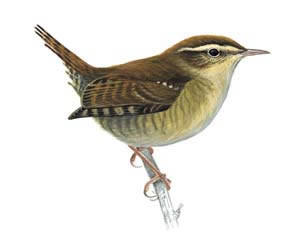 Wren
Wren
The wren is a tiny brown bird, although it is heavier, less slim, than the even smaller goldcrest. It is dumpy, almost rounded, with a fine bill, quite long legs and toes, very short round wings and a short, narrow tail which is sometimes cocked up vertically. For such a small bird it has a remarkably loud voice. It is the commonest UK breeding bird, although it suffers declines during prolonged, severely cold winters.
All bird pictures and text extracted from RSPB website © 2007 The Royal Society for the Protection of Birds. Charity registered in England and Wales no 207076, in Scotland no SCO 37654
